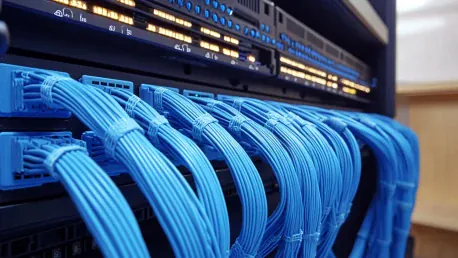AT&T has embarked on an ambitious three-year network modernization plan that promises to reshape the telecommunications landscape. This comprehensive initiative aims to nearly double its fiber network coverage, phase out legacy copper infrastructure, and incorporate open Radio Access Network (RAN) technology. The plan is designed to enhance network efficiency, embrace open technology, and deliver converged network services at scale. AT&T’s chief operating officer, Jeff McElfresh, has outlined the company’s commitment to these goals, emphasizing the importance of growth through network enhancements. The endeavor reflects AT&T’s broader strategy to stay ahead of the technology curve and meet the evolving demands of its vast customer base.
Expanding Fiber Network Coverage
AT&T’s modernization plan includes a significant expansion of its fiber network. The goal is to nearly double the current coverage, providing faster and more reliable internet services to a broader customer base. This expansion is crucial for meeting the growing demand for high-speed internet, driven by the increasing number of connected devices and the rise of data-intensive applications.
The fiber network expansion will also support AT&T’s 5G rollout, providing the necessary infrastructure for high-speed, low-latency connections. By investing in fiber, AT&T is positioning itself to deliver next-generation services that require robust and reliable connectivity. This move is expected to enhance customer satisfaction and drive growth in both residential and business markets. The capability to handle more considerable bandwidth and faster speeds will also allow AT&T to remain competitive in a market where customers constantly seek better and more efficient services.
In addition to expanding coverage, AT&T is focused on improving the efficiency of its fiber network. This includes optimizing network assets, streamlining power configurations, and addressing “radio debt” to enhance overall network performance. By modernizing its fiber infrastructure, AT&T aims to create a more resilient and efficient network that can support future technological advancements. The emphasis on future-proofing ensures that the network can accommodate emerging technologies and higher data speeds, keeping pace with customer needs and industry trends.
Phasing Out Legacy Copper Infrastructure
As part of its modernization efforts, AT&T plans to phase out its legacy copper infrastructure. This move is driven by the need to replace outdated technology with more efficient and reliable alternatives. Copper networks are increasingly unable to meet the demands of modern telecommunications, particularly in terms of speed and capacity. Phasing out copper infrastructure will allow AT&T to focus on more advanced technologies, such as fiber and 5G.
This transition aims to improve service quality and reduce maintenance costs, as fiber networks are less prone to issues like signal degradation and interference. By moving away from copper, AT&T is ensuring that its network is future-proof and capable of supporting the latest innovations in telecommunications. The shift from copper to fiber represents a strategic pivot designed to improve the customer experience while lowering operational costs.
The transition from copper to fiber will be a complex process, requiring careful planning and execution to minimize disruptions to customers. AT&T has spent a year refining its processes to ensure a smooth transition, with the goal of completing the upgrade by late 2026 or early 2027. This phased approach will allow AT&T to maintain consistent service quality while modernizing its network. The detailed planning highlights the company’s commitment to delivering uninterrupted services while steadily moving toward a more advanced infrastructure.
Embracing Open RAN Technology
A key component of AT&T’s modernization plan is the incorporation of open Radio Access Network (RAN) technology. Open RAN aims to disrupt the traditional telecom network equipment market by allowing for greater interoperability and flexibility. This approach enables AT&T to integrate various open radios effectively, creating a more versatile and efficient network. The adoption of open RAN technology represents a significant step toward modernizing the network, promoting innovation, and reducing costs.
Ericsson has been chosen as the foundational provider for AT&T’s open network, leveraging their existing relationship to facilitate a smoother transformation. In addition to Ericsson, AT&T is working with other radio vendors, such as Fujitsu and Mavenir, for urban area deployments. These vendors were selected for their mature offerings, which align with AT&T’s current needs. The collaboration with multiple vendors indicates a strategy to harness diverse expertise and solutions to build a robust and adaptable network.
The adoption of open RAN technology is part of a larger strategy to create a network that is energy- and spectrum-efficient, fully digitalized, and capable of supporting a wide range of applications. By embracing open technology, AT&T aims to lower costs, manage spectrum more efficiently, and create an ecosystem that fosters innovation and collaboration. These efforts will enable AT&T to offer cutting-edge services while maintaining operational efficiency and achieving significant cost savings.
Enhancing Network Efficiency and Densification
AT&T’s modernization plan also focuses on enhancing network efficiency and densification. This involves optimizing the placement and configuration of cell sites, using technologies like drones and AI to ensure they are positioned for maximum performance. By touching every cell site in its footprint, AT&T aims to create a more efficient and resilient network. The use of advanced technologies for network optimization underscores AT&T’s commitment to leveraging innovation to drive operational efficiency.
Network densification is particularly important for supporting the growing demand for data and the rollout of 5G services. By increasing the number of small cells and mission-specific radiating points, AT&T can improve coverage and capacity in high-traffic areas. This approach will help AT&T manage traffic growth in a spectrum-constrained environment, ensuring consistent service quality. The densification of the network allows it to handle more connections simultaneously, providing enhanced experiences for customers.
In addition to physical infrastructure improvements, AT&T is also focusing on innovative traffic management techniques. These methods aim to optimize the use of available bandwidth, allowing AT&T to handle increasing data demands without relying on additional spectrum. By combining physical and operational enhancements, AT&T is creating a network that is both efficient and scalable. This dual focus on infrastructure and traffic management sets the stage for a more resilient and future-ready network.
Leveraging Third-Party Capabilities and Developer Ecosystem
AT&T has undertaken an extensive network modernization initiative set to span three years, aiming to revolutionize the telecommunications sector. This ambitious plan involves nearly doubling its fiber network reach and phasing out outdated copper infrastructure. Additionally, the strategy incorporates the adoption of open Radio Access Network (RAN) technology. The goal is to boost network efficiency, leverage open technology, and deliver comprehensive network services on a large scale. Jeff McElfresh, AT&T’s chief operating officer, has highlighted the company’s dedication to these objectives, pointing out the crucial role of network enhancements in driving growth. This venture is part of AT&T’s broader approach to maintaining a competitive edge in technology and addressing the shifting needs of its large customer base. By modernizing its network infrastructure, AT&T aims to be at the forefront of technological innovation and ensure reliable services for its customers. The plan underscores AT&T’s commitment to progress and adapting to the increasingly digital world.









